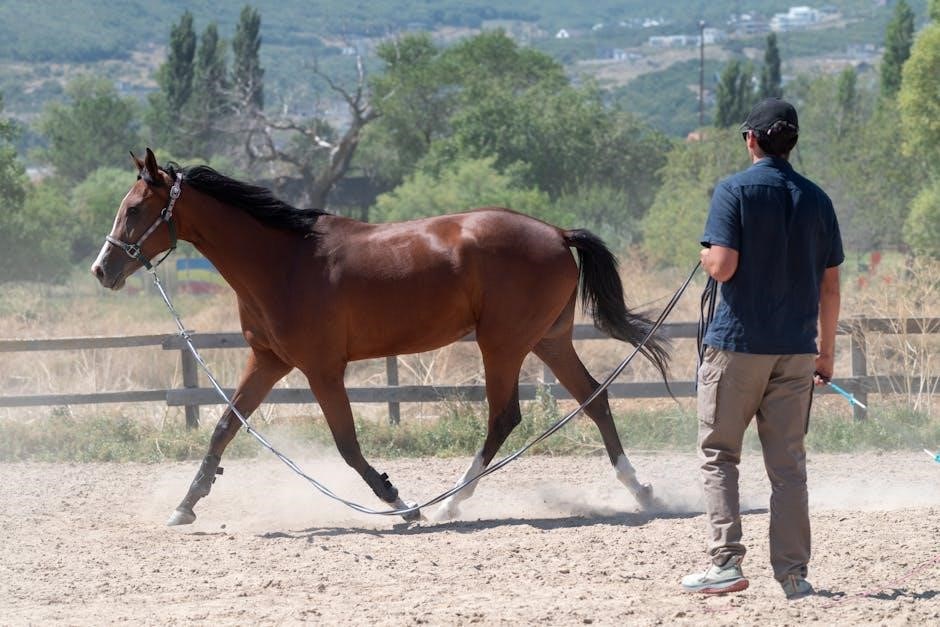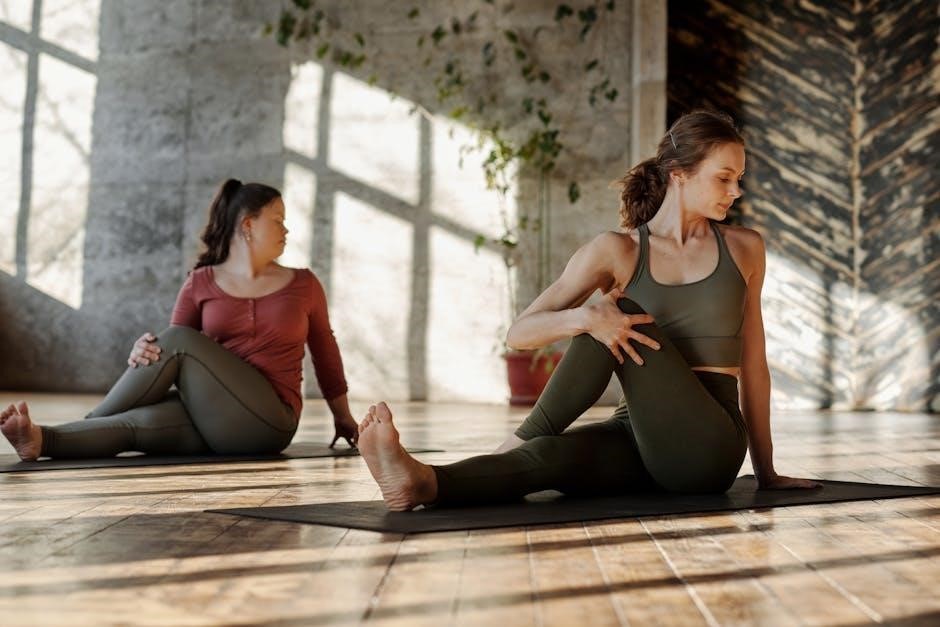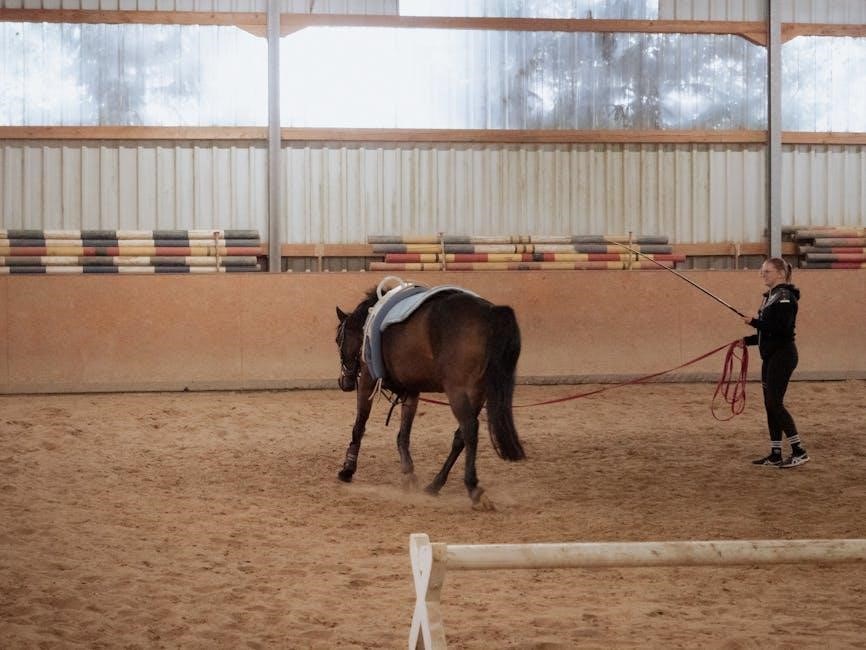A manual trainer MTB is a device designed to help riders master balancing and rear-wheel control by lifting the front wheel, enhancing bike handling skills for all levels.
1.1 What is a Manual Trainer MTB?
A manual trainer MTB is a specialized device designed to help mountain bikers practice and master the manual technique, which involves balancing on the rear wheel without pedaling. It typically holds the rear wheel in place, allowing riders to focus on finding and maintaining the balance point. This tool is essential for improving rear-wheel control, muscle memory, and overall bike handling skills in a controlled and safe environment. It’s a popular training aid for riders of all skill levels, from beginners to advanced cyclists, aiming to enhance their trail performance and mastery of technical maneuvers.
1.2 Importance of Manual Training in MTB
Manual training is essential for MTB riders as it enhances balance, stability, and rear-wheel control, critical skills for navigating technical terrain. By practicing manuals, riders develop muscle memory and improve their ability to maintain control during challenging trails. This training boosts confidence and precision, allowing riders to tackle obstacles more effectively. Consistent practice with a manual trainer accelerates skill development, making it a valuable tool for riders seeking to elevate their performance and mastery of advanced techniques. It’s a key component in building the foundational skills necessary for progressing in mountain biking.

Benefits of Using a Manual Trainer MTB
Using a manual trainer MTB improves balance, stability, and rear-wheel control, helping riders develop muscle memory and confidence for advanced techniques like manuals and wheelies.
2.1 Improving Balance and Stability
A manual trainer MTB enhances balance and stability by allowing riders to practice lifting the front wheel and maintaining control on the rear wheel. By holding the rear wheel in place, the trainer forces riders to focus on their body positioning and weight distribution. This targeted practice helps develop the muscle memory needed to stay balanced during manuals and other technical maneuvers. Regular use of a manual trainer improves overall stability, making it easier to navigate challenging terrain with confidence and precision.
2.2 Enhancing Rear-Wheel Control
A manual trainer MTB is instrumental in enhancing rear-wheel control, a critical skill for mastering manuals. By holding the rear wheel in place, riders can focus on subtle weight shifts and body positioning to maintain balance. This targeted practice improves the ability to control the rear wheel, especially when leaning back or navigating technical terrain. Regular use of a manual trainer helps riders develop muscle memory for rear-wheel management, translating to better control and confidence on the trails. It allows riders to refine their technique in a controlled environment, making rear-wheel control second nature.
2.3 Building Muscle Memory
Manual trainers are excellent for building muscle memory by allowing riders to repeatedly practice balance and control. Through consistent sessions, riders develop instinctive movements, such as shifting weight and applying brakes, which become second nature. The MTB Hopper and Ninja MTB Manual Machine are popular choices for this purpose, offering a stable platform to hone skills. By reinforcing proper techniques, riders can transition these muscle memory skills seamlessly to real-world trail scenarios, enhancing overall performance and confidence. This repetition and practice are key to mastering advanced techniques and improving trail performance effectively.
2.4 Boosting Confidence for Advanced Techniques
Using a manual trainer MTB significantly boosts confidence for advanced techniques by allowing riders to practice in a controlled environment. Mastery of balance and rear-wheel control translates to increased assurance on the trails. Riders can experiment with manuals and wheelies without the fear of crashing, building the confidence needed for challenging terrain. The immediate feedback from the trainer helps riders refine their skills, making advanced maneuvers feel more achievable. This newfound confidence enables riders to tackle technical sections with precision and poise, elevating their overall performance and enjoyment of mountain biking.

How to Use a Manual Trainer MTB
Mount your bike, adjust the trainer for your bike’s specs, and start with static balance. Gradually incorporate dynamic movements to refine your manual skills effectively.
3.1 Setting Up the Trainer
Setting up your manual trainer MTB begins with ensuring compatibility. Adjust the device for your bike’s tire size using spacers as specified. Secure your bike firmly in the cradle, ensuring the rear wheel is held in place. Tighten all connections to prevent movement during training. Check the weight limit and place the trainer on a flat, stable surface. Some models may require attaching a safety strap to the front wheel to limit excessive leaning. Double-check all adjustments to ensure safety and optimal performance before starting your session.
3.2 Finding the Balance Point
Finding the balance point on your MTB manual trainer involves shifting your body weight until the bike feels stable on the rear wheel. Start by standing over the bike with your feet shoulder-width apart. Gently lean back, keeping your knees slightly bent, until the bike begins to lift. Adjust your weight forward and backward to locate the sweet spot where the bike balances naturally. This process requires patience and practice to develop muscle memory and improve stability. Consistent effort will help you master the balance point, enhancing your overall control and confidence on the bike.
3.3 Practicing Static and Dynamic Balance
Practicing static and dynamic balance on a manual trainer MTB is essential for mastering manual skills. Start with static balance by mounting the bike and adjusting your body position to find stability. Shift your weight slightly to lift the front wheel, focusing on maintaining control. For dynamic balance, gently rock the bike back and forth while standing, engaging your core and adjusting your weight. This mimics real-world movements, improving your ability to react on the trails. Regular practice enhances muscle memory and overall bike control, making it easier to maintain balance during rides.
3.4 Engaging the Rear Brake for Control
Engaging the rear brake while using a manual trainer MTB is crucial for maintaining control and preventing the bike from tipping too far backward. Gently squeezing the brake allows you to stabilize the bike and focus on balance. This technique mimics real-world scenarios, helping riders develop muscle memory for rear-wheel control. Modern manual trainers often include features that limit excessive movement, making it easier to practice braking and balance simultaneously. Mastering this skill builds confidence and enhances trail performance by improving control during manuals and technical maneuvers.

Types of Manual Trainers MTB
Popular types include the Ninja MTB Manual Machine, MTB Hopper Balance Manual Machine, and DIY manual trainers, each designed to enhance balance and rear-wheel control skills.
4.1 Ninja MTB Manual Machine
The Ninja MTB Manual Machine is a top-rated training tool designed for mastering manuals. It features a sturdy, foldable design with a weight limit of 120kg, making it suitable for most riders. Adjustable straps ensure compatibility with various tire sizes, while its durable construction provides long-lasting performance. Riders praise its effectiveness in building muscle memory and rear-wheel control. The machine holds the rear wheel in place, simulating real-world manual conditions, and comes with a 2-year warranty for added reliability. It’s an excellent choice for both beginners and professionals looking to enhance their balance and control skills.
4.2 MTB Hopper Balance Manual Machine
The MTB Hopper Balance Manual Machine is a versatile training tool designed to enhance balance and rear-wheel control. It supports various wheel sizes (24-29 inches) and tire widths (1.5-4.0 inches), making it compatible with most MTB setups. The machine features a tilting cradle and a front-wheel strap for added stability, allowing riders to focus on finding their balance point. Its lightweight, foldable design makes it ideal for home use or travel, with a quick 5-minute assembly and disassembly process. Riders praise its effectiveness in improving manual skills and overall bike handling, offering a user-friendly solution for skill development.
4.3 DIY Manual Trainers
DIY manual trainers offer a cost-effective and customizable solution for riders seeking to improve their manual skills. Often built from materials like wood, PVC, or metal, these trainers provide a platform to practice balancing and rear-wheel control. They can be tailored to fit specific bike sizes and tire widths, making them a versatile option for riders with unique setups. While they may lack the advanced features of commercial products, DIY trainers encourage creativity and provide a practical way to develop muscle memory and balance. They are also lightweight and portable, making them ideal for riders who enjoy working on projects and prefer a hands-on approach to training.

Key Features of Manual Trainers MTB
Manual trainers feature adjustable designs, portability, durable construction, and safety features, making them ideal for home use and travel while enhancing balance and control skills effectively.
5.1 Adjustable and Compatible Design
Manual trainers MTB are designed with adjustability to accommodate various bike sizes and tire widths, ensuring compatibility for a wide range of riders. Many models feature adjustable straps and tilt mechanisms, allowing precise fitting for different bike frames and wheel sizes. This versatility makes them suitable for riders with diverse setups, from 24-inch wheels to 29-inch models and tire widths between 1.5 to 4.0 inches. The adjustable design enhances usability, enabling riders to customize the trainer to their specific needs, whether for home practice or travel, ensuring effective and efficient skill development across different bike configurations.
5.2 Portability and Foldable Options
Manual trainers MTB are designed with portability in mind, often featuring foldable frames for easy transport and storage. Many models can be disassembled into smaller parts, making them ideal for riders who need to carry their trainers to different locations. The lightweight construction and compact design allow for space-saving storage, perfect for home use or travel. This portability ensures that riders can practice their manual skills anywhere, without sacrificing convenience or practicality. Foldable options enhance ease of use, allowing trainers to be quickly set up and stored away, making them a practical choice for riders on the go.
5.3 Durable Construction Materials
Manual trainers MTB are built with durable materials like steel or aluminum, ensuring stability and longevity. These materials withstand regular use and provide a sturdy platform for practicing manuals. The robust construction allows riders to focus on their technique without worrying about the trainer’s integrity. High-quality materials also contribute to the trainer’s ability to support various bike sizes and weights, making them reliable for both beginners and experienced riders. The use of durable materials ensures that the trainer remains a long-lasting tool for improving bike handling skills and mastering advanced techniques.
5.4 Safety and Stability Features
Manual trainers MTB often include safety and stability features such as rubber feet for grip, preventing movement during use. Some models incorporate safety straps to secure the front wheel, limiting excessive leaning and reducing the risk of accidents. The sturdy design ensures the trainer remains stable, even during intense practice sessions. These features prioritize rider safety while providing a secure platform to develop balance and control. By minimizing risks, riders can focus on improving their manual skills with confidence. Safety straps and non-slip surfaces further enhance stability, making the trainer suitable for riders of all skill levels.

Choosing the Right Manual Trainer MTB
Choosing the right manual trainer MTB involves considering compatibility with bike size and tire width, weight limits, ease of assembly, and user reviews for optimal performance and safety.
6.1 Compatibility with Bike Size and Tire Width
Ensuring your manual trainer is compatible with your bike’s size and tire width is crucial for effective training. Most trainers support wheel sizes from 24 to 29 inches and tire widths between 1.5 to 4.0 inches. Adjustable straps and tilt mechanisms allow customization to fit various bike frames, making them versatile for different setups. This adaptability ensures that riders with diverse bikes can use the same trainer effectively, enhancing usability across multiple bikes and riding styles. Proper compatibility guarantees stability and safety during practice sessions, allowing riders to focus on improving their manual skills without equipment constraints.
6.2 Weight Limits and Stability
Manual trainers are designed with weight limits and stability features to ensure safe and effective practice. Most models support up to 120kg, accommodating a wide range of riders. Rubber feet and adjustable straps enhance grip and prevent movement during use. The sturdy construction, often using materials like steel or aluminum, ensures durability and stability. These features allow riders to focus on improving their manual skills without worrying about equipment failure. Stability is further enhanced by the trainer’s ability to hold the rear wheel securely, providing a solid platform for balancing and rear-wheel control, which is essential for mastering advanced techniques confidently.
6.3 Ease of Assembly and Disassembly
Manual trainers are designed for convenience, with many models offering quick and easy assembly and disassembly. The Ninja MTB Manual Machine, for example, disassembles into 15 parts for easy transport and storage. Similarly, the MTB Hopper Balance Manual Machine can be assembled in just 5 minutes, making it user-friendly. Lightweight and foldable designs further enhance portability, allowing riders to practice anywhere. These features ensure that setting up and storing the trainer is hassle-free, making it ideal for both home use and travel. This ease of use encourages consistent practice and skill improvement without added inconvenience.
6.4 User Reviews and Recommendations
Users highly recommend manual trainers like the Ninja MTB Manual Machine and MTB Hopper for their effectiveness in improving skills. Riders praise their durability, portability, and ease of use. Many highlight how these trainers have boosted their confidence and control on the trails. The foldable design and adjustable features are particularly appreciated for convenience. Reviews often mention the value of these tools for both beginners and advanced riders. The mountain biking community strongly endorses these trainers, citing noticeable improvements in balance and rear-wheel control. Positive feedback underscores their role in accelerating skill development and enhancing overall riding performance.

Safety Tips for Using a Manual Trainer MTB
Ensure proper setup on a stable surface, wear protective gear, and practice in a clear, flat area. Avoid excessive leaning and use safety straps if available.
7.1 Ensuring Proper Setup and Stability
Proper setup and stability are crucial for safe and effective use of a manual trainer MTB. Begin by ensuring the trainer is placed on a flat, stable surface and adjust it according to your bike’s specifications. Use spacers if necessary to accommodate your tire width, as specified in the product guide. Secure your bike firmly in the cradle, ensuring the rear wheel is held in place. Tighten all connections to prevent movement during training. If available, attach a safety strap to the front wheel to limit excessive leaning. Double-check the weight limit and ensure the trainer is stable before starting your session. Always ensure the area around the trainer is clear of obstacles to minimize risks.

7.2 Wearing Protective Gear
Wearing protective gear is essential when using a manual trainer MTB to minimize the risk of injury. Always wear a helmet to protect your head from impact in case of a fall. Knee pads and elbow pads are also recommended to prevent abrasions and bruises. Gloves can improve grip and reduce hand fatigue while practicing. Proper footwear, such as sturdy shoes or cycling cleats, ensures better control and stability. Protective gear not only enhances safety but also boosts confidence, allowing riders to focus on improving their skills without unnecessary risks. Safety should always be a priority when training on a manual trainer.
7.3 Practicing in a Safe Environment
Practicing with a manual trainer MTB requires a safe and controlled environment to minimize risks. Choose a flat, open space free from obstacles, ensuring there’s enough room to move around the bike. The surface should be even and dry to prevent slipping. Avoid areas with breakable objects or fragile furniture. Consider using a soft surface like grass or a training mat to cushion potential falls. Clear the area of distractions to maintain focus. A safe environment allows riders to concentrate on technique and balance without worrying about collisions or damage. This setup ensures effective and worry-free practice sessions.
7.4 Avoiding Excessive Leaning
Avoiding excessive leaning is crucial when using a manual trainer MTB to prevent losing control or tipping over. Start by maintaining proper body positioning, with knees slightly bent and weight centered over the bike. Gradually shift your weight backward to lift the front wheel, but avoid leaning too far, as this can destabilize the bike. Use the rear brake sparingly to control movement and maintain balance. Excessive leaning can lead to loss of control, so focus on subtle weight shifts and practice within your comfort zone. This approach ensures safer and more effective practice sessions.

Maintenance and Storage of Manual Trainers MTB
Regularly clean and lubricate moving parts, store in a dry location, and check for wear. Follow manufacturer guidelines to ensure longevity and optimal performance of the trainer.
8.1 Cleaning and Lubricating Moving Parts
Regular cleaning and lubrication of moving parts are essential for maintaining the performance and longevity of your manual trainer MTB. Use a soft cloth and mild detergent to wipe down the frame and moving components, ensuring no dirt or grime accumulates. Rinse thoroughly and dry to prevent rust. Apply a silicone-based lubricant to pivot points and axles to keep them running smoothly. Avoid over-lubrication, as it can attract dust. Inspect these areas regularly to ensure proper function and prevent wear. This routine maintenance will help your trainer operate effectively and extend its lifespan.
8.2 Storing in a Dry and Secure Location
Storing your manual trainer MTB in a dry and secure location is crucial to protect it from damage and extend its lifespan. Choose a cool, moisture-free area away from direct sunlight to prevent rust and material degradation. Ensure the space is level and stable to avoid accidental tipping. Before storage, clean the trainer thoroughly and consider using a protective cover to shield it from dust. Secure the trainer to prevent movement, especially in areas prone to earthquakes or heavy foot traffic. Proper storage ensures your trainer remains in optimal condition for future use.
8.3 Checking for Wear and Tear
Regularly inspect your manual trainer MTB for wear and tear to ensure optimal performance and safety. Check the frame for rust or dents, and examine bolts and straps for tightness and fraying. Lubricate moving parts to prevent corrosion and maintain smooth operation. Look for signs of excessive stress on the rear wheel holder or balance point mechanism. Addressing these issues promptly prevents further damage and ensures the trainer remains stable and functional. Regular maintenance extends the lifespan of your manual trainer, keeping it reliable for consistent training sessions.
8.4 Following Manufacturer Guidelines
Adhering to the manufacturer’s guidelines is essential for the safe and effective use of your manual trainer MTB. These guidelines provide specific instructions for assembly, weight limits, and maintenance to ensure optimal performance. Always check the recommended tire sizes and bike compatibility to avoid damage. Follow the suggested maintenance schedules to keep the trainer in good condition. Ignoring these guidelines can lead to equipment failure or unsafe training conditions. By following the manufacturer’s advice, you can extend the lifespan of your manual trainer and enjoy a secure and productive training experience.

Expert Tips for Effective Manual Training
- Start with short sessions to build focus and consistency.
- Use video feedback to analyze and improve your form.
- Incorporate strength training to enhance overall stability and control.
9;1 Starting with Short Practice Sessions
Begin with short, focused practice sessions to build consistency and avoid burnout. Start with 10-15 minute sessions, gradually increasing as you gain comfort. This approach helps develop muscle memory and maintains focus. Filming your sessions provides instant feedback, revealing areas for improvement. Prioritize proper form and balance over duration. Consistency is key—regular short practices yield better results than occasional long ones. This method ensures steady progress and keeps training enjoyable and effective for mastering manual skills.
9.2 Focusing on Proper Body Positioning
Proper body positioning is crucial for effective manual training. Keep your chest up, elbows slightly bent, and knees bent to lower your center of gravity. Shift your weight slightly back to balance on the rear wheel. Focus on keeping your head up and eyes forward to maintain control. Practice these movements on the manual trainer to build muscle memory. Consistent attention to body positioning improves balance, stability, and overall technique, translating to better performance on the trails.
9.3 Using Video Feedback for Improvement
Video feedback is a powerful tool for refining manual skills. By recording your practice sessions on the manual trainer, you can analyze your form, balance, and control. This visual insight helps identify areas for improvement, such as weight distribution or body alignment. Many riders find that their perception of their technique differs from reality, and video feedback provides an honest assessment. Regularly reviewing and adjusting your approach based on this feedback accelerates learning and enhances overall performance. It’s a simple yet effective method to track progress and master the fundamentals of manual training.
9.4 Incorporating Strength Training
Incorporating strength training into your routine can significantly enhance your manual skills. Focus on building core strength, leg power, and upper body stability through exercises like planks, squats, lunges, and pull-ups. These workouts improve overall muscle endurance and balance, which are crucial for maintaining control during manuals. While strength training alone won’t master the technique, it complements practice on the manual trainer by boosting stability and confidence. A well-rounded fitness regimen, combined with dedicated manual training, accelerates skill development and enhances trail performance.
A manual trainer MTB is an essential tool for improving balance, rear-wheel control, and muscle memory, helping riders build confidence and master advanced techniques effectively.
10.1 Summary of Key Points
A manual trainer MTB is a valuable tool for improving balance, stability, and rear-wheel control. It helps riders master the balance point, build muscle memory, and boost confidence for advanced techniques. Available in types like the Ninja MTB Manual Machine and MTB Hopper, these devices offer adjustable, portable, and durable designs. They accommodate various bike sizes and tire widths, ensuring compatibility and versatility. By focusing on proper body positioning and rear brake control, riders can enhance their skills safely and effectively. Consistent practice with a manual trainer leads to better trail performance and overall riding confidence.
10.2 Final Thoughts on Manual Trainer MTB
A manual trainer MTB is an essential tool for riders seeking to enhance their balance, stability, and rear-wheel control. It provides a controlled environment to master the balance point and build muscle memory, which are critical for advanced techniques. With options like the Ninja MTB Manual Machine and MTB Hopper, riders can choose a trainer that suits their needs. These devices are portable, durable, and designed for compatibility with various bike sizes. By incorporating a manual trainer into their training regimen, riders can achieve significant improvements in their skills, leading to greater confidence and precision on the trails.